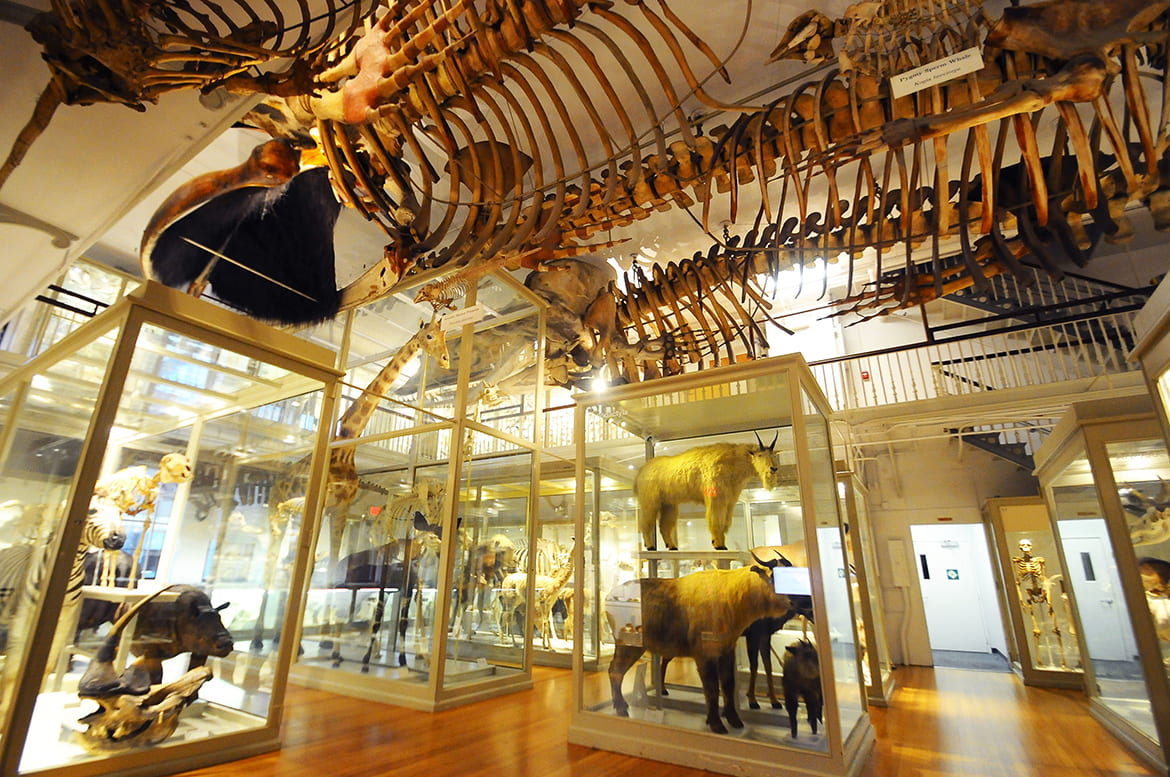
In Review
With Agassiz, Darwin, and God in a Collection’s Inner Sanctum
By Peter Bebergal
Likened to an outboard motor, with all its attendant parts and pieces, the flagellum of bacteria is an incredibly complex organic mechanism. It’s so complicated, in fact, that many people believe it is the surest proof that some intelligence was behind its design. If you removed any one little part of the flagellum, the argument goes, it wouldn’t function. There is no way that the chaotic template of evolution can explain it. Biochemist Michael Behe refers to something like this little miraculous propeller as irreducible complexity. There is no previous form in nature that the propeller evolved from, no “modification” of some original form. This is an old argument for the existence of God. The most famous precursor comes by way of the eighteenth-century theologian William Paley. In his treatise Natural Theology, Paley offers the following anecdote. He is walking in the country and comes across a watch. How did the watch get there? Had it been there all along, like the stones and the trees? Further inspection reveals that the watch is an incredibly complicated device. Each gear, each spring, is necessary for the function of the whole. Nothing is added. Nothing omitted. Ah ha! It must have had a watchmaker, for it could not appear magically out of the ether. It was made by intelligence and deliberate design. How then, can one gaze upon the natural world in all its complexity and perfection, each thing in its place, like the works of a watch, and not see in these forms the hand of a creator? There still exists the remnant of where Paley’s dictum was once made manifest, the Harvard Museum of Comparative Zoology, founded in 1859 by the passionate, slightly obsessive, and certainly controversial Louis Agassiz, whose 200th birthday was marked by Harvard over the last year. Agassiz also believed that studies of natural history, through a rigorous science of classification, are “but translations into human language of the thoughts of the Creator.”1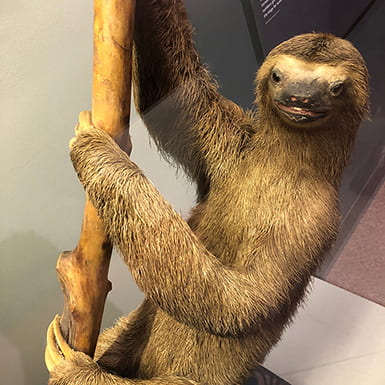
Sloth, at the Harvard Museum of Natural History. Photo by Kristie Welsh
There are, in both the larger sense and in microcosm, two museums. The public exhibitions, or the outer museum, are made up mainly of crumbling old stuffed animals. The inner museum is the institution’s real collection, over a million specimens of great and revered scientific value, off limits to the public. Within the outer museum this duality gets played out again. What here is of scientific value? And among these, where might one discover God? Is God in the details or the spectacle? In Joseph’s dream, or in the giant molars of a hippo? The collection, now all but hidden from the public, was once offered as this surest proof of the existence of God. Gradually, that vision was housed away for research only, and what was not of scientific value, the spectacle of fangs and fur, was left to collect dust in the hallowed halls.
The Museum of Comparative Zoology (MCZ) falls under the heading “Harvard Museums of Natural History,” which includes the MCZ’s public exhibits, the Botanical Museum, known for its staggeringly beautiful and otherworldly glass flower collection, and the Mineralogical and Geological Museum. While the public museum wants to educate and inform, its mission is quite different form the original idea of the museum.
It is impossible to know which specimens were part of the original collection first started by Louis Agassiz (and later expanded by his son Alexander). The first incarnation of the museum made no inner/outer distinctions. All the evidence suggests that Agassiz believed that the whole collection should be available for inspection. Agassiz thought most of the visitors would be other scientists, but he also hoped to impress the class of folks that frequented museums, the same class that donated. The museum today is clearly demarcated. The inner museum is where the valuable specimens are stored, the ones that are researched and studied and that are cared for with thoughtfulness and precision. Many of the cases are locked, and for all intents and purposes, unless one knows about them, the casual patron of the public exhibits is all but ignorant of the actual collection. As it is, many of the exhibits in the outer museum are falling apart. A chimpanzee precariously hangs by a branch, his arm showing wear from hundreds of years of holding on. A black rhino with a cracked neck, a dangerous animal in the wild, is in a sad state of decay. The spectacle of its wildness is withering.
The collection that is now all but hidden from the public was once offered as the surest proof of the existence of God.
Some years ago I was fortunate enough to make the acquaintance of Douglas Causey, formerly a senior biologist at the museum. I originally contacted Doug to see if he could give me a tour of the bird exhibit at Harvard. When we first met he led me through the halls into the bird room and then passed through it to an elevator where he punched in a special code. I explained that I wanted to see the bird collection. He explained that he was taking me there.
A few minutes later we were in a room that was considerably larger than the bird room in the public halls. The walls and floors were lined with ceiling high drawer units. Doug began to open drawers. Inside each were dozens of bird specimens, called skins. There are, Doug told me, more than 500,000 birds in the collection. “This is the real museum,” he said. Doug was the first to suggest the inner/outer idea to me. The collection outside is the quaint exhibit for the public. But for the biologists and zoologists who work in the MCZ, the inner collection is a great source of pride, the holy grail of natural history museums.
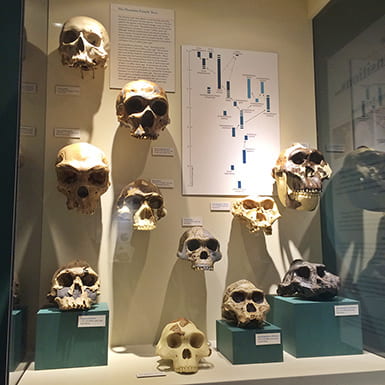
Hominid evolution display at the Harvard Museum of Natural History. Photo by Kristie Welsh

Bengal Tiger at the Harvard Museum of Natural History. Photo by Kristie Welsh
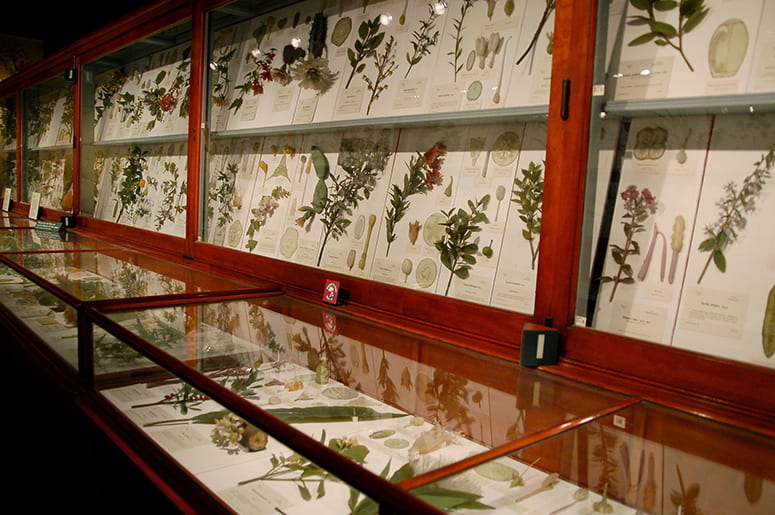
Glass Flowers at the Harvard Museum of Natural History. Photo Curious Expeditions by on Flickr (CC BY-NC-SA 2.0)
James Hanken is the current director of the MCZ. But, to be clear, he is not the director of that part of the museum which is for the public. Recently, he took me around the museum and again, as with Doug Causey, I could see how the worlds of the two museums are strikingly different. In the offices of the MCZ, which includes the small but cozy Ernst Mayr Library, even the hallways are lined with cabinets. Hanken opened one of the cabinets for me (which he struggled with, as it had recently been painted and the painters didn’t watch out for the edges) and pulled out a drawer filled with fossil specimens. He held it in such a way as to demonstrate that despite its size he could hold it himself. The drawer was just right. Not too short, but deep enough to hold a variety of specimens. Not too heavy, even when full. In a sense, a perfect drawer. Hanken explained that these are referred to as Agassiz Drawers, designed by Alexander for the inner museum. This type of drawer became the standard by which natural history specimen drawers are made.
At each juncture there are huge rooms with larger cabinets, and in the office that once belonged to Stephen Jay Gould, the shelves must be 20 feet high, filled to the brim with specimens. Even the tops are used to store gigantic bones, likely belonging to some prehistoric creature. I wanted to ask Hanken if they were brontosaurus bones, but didn’t want to appear naïve if they turned out to be something less exotic.
After a short tour of the MCZ, Hanken took me into the Hall of Mammals. Hanken, much like Causey, is the kind of scientist that nonscientists envy. He keeps things close to the vest, but despite that, he still gives himself away. There is a wonder and curiosity that illuminates his personality. All these species and all this diversity are the result of mutation, chance, and selection, but there is still something ineffable about the whole thing, maybe just the fact that anything exists at all. As we walk through the hall, Hanken explains why there has to be two museums. On the one hand, echoing Gray’s nineteenth-century view, not only must the scientific specimens be protected from any possible loss or damage, but the public would be overwhelmed by the actual collection. The public museum, as it is, offers what is known as a synoptic, or representative, collection. You don’t need to see every species of shark. You just need to see enough to instruct, to learn a little bit about what a shark is, as a kind of animal. On the other hand, the specimens in the public museum don’t really have any scientific value. Hanken admitted that some of them are sufficiently rare, but not enough to have an impact on the research of the MCZ.
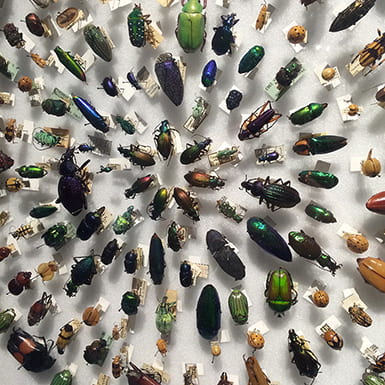
Insects displayed at the Harvard Museum of Natural History. Photo by Kristie Welsh
The irony is, if Agassiz had hoped that his museum, a museum accessible to the public, would reveal God’s handiwork, there is not much here that inspires those kinds of feelings. It is in the inner museum, with its rooms and rooms and rows and rows of millions of specimens that inspires the religious vertigo of a cathedral. But my own sense of wonder at the sheer number of specimens is not likely to be the same kind of religious sentiment that drove Agassiz. His was a more subtle view of God’s design.
Compared with traditional creationism, which asserts that God created the world pretty much as it is explained in the book of Genesis, Agassiz’s creationism is what is known as “special.” According to Genesis, the world was created in six days (the number is often quoted as seven, but the story tells us God rested on that day, so the actual creating took place in six) and from the writing of this, it would have been about 6,000 or so years ago. Certainly not enough time for those bones in Gould’s old office to be anything but a bison or a bear. Agassiz was far from being a biblical literalist and, like many scientists of his days, accepted the idea of a very old earth. In fact, Agassiz was one of the first naturalists to argue persuasively that there was indeed an ice age. But like their young-earth creationist cousins, these old-earth creationists believed that species were placed at a certain time and in a certain place by God.
Even the most atheistic scientists drop the word “creation” when talking about the natural world. What is this instinct to assign, even if only semantically, a sense of deistic intent on everything from volcanoes to viruses? To talk about God in the same breath one talks about creation is to conjure up the Genesis story. But is there much difference between what is offered in this story and the displays in the public halls of the MCZ? There is an area for dinosaurs, including our mighty friend the kronosaurus (“the great sea monsters”), an area for fish (“the waters bring forth swarms of living creatures”), for birds (“that fly above the earth across the expanse of time”), for mammals (“wild beasts of every kind and cattle of every kind”), and even a few beetles tacked up in a small display case (“the creeping things that creep upon the earth”). This is a visual representation of literalism, and unless we are educated to see the mythology and the metaphor that this story contains, what else is one supposed to see here, if not simply the diversity of living creatures? But Agassiz, a man who probably quarreled with his Bible for its vague and useless scientific offerings, wanted the museum to be something so much more. Literalism can’t teach us anything about the world. We need to know something about the complexity. And ironically, as Polly Winsor explained, “It was not fossils or DNA that convinced scientists of evolution, but the same thickening of evidence about taxonomic relationships that excited Louis. His argument about how it could only be explained by divine intelligence fell flat, because it could obviously also be explained by evolution.”
And so in the last 10 years, Harvard has done an admirable job of adding a number of important displays around the various rooms of the museums, displays that speak to this complexity, that reveal the evidence of evolution, evidence that Agassiz himself was starting to be impressed by in his final days. Even more impressive, the museum has, at the time of this writing, established a new series of permanent rotating exhibits. Sadly, the first of these has taken over what used to be the bird collection, my personal favorite. That said, the new exhibit is the most impressive in the whole museum. The entire room has been transformed into a collection of arthropods, which includes all manner of insects, spiders, and crabs and lobsters. As I considered the displays, brightly lit cases filled with lovingly preserved specimens, I realized there is more to learn in this one room than in the whole rest of the museum with its moldering mammals.
Is God here in this room of creepy crawly things with their complex joints and exoskeletons? Can God be here and Darwin also? Maybe we should go to Darwin for the details and to God for the spectacle after all? This is what the intelligent design proponents are missing. You really can’t prove God in the structure of a flagellum, because, as Agassiz was starting to realize, the evidence used for design also proves evolution, and proves it more elegantly. Faith doesn’t need these facts. It just needs the sheer marvel of it all.
As for the future of the public museum, it remains to be seen what the curators will do with the animal exhibits. Will they retain for historical purposes the hall of mammals (an important influence on other museums)? And will the museum ever display, in any meaningful and explicit way, the spirit behind Louis Agassiz’s scientific genius—his faith?
Notes:
- Louis Agassiz, Essay on Classification, ed. Edward Lurie (Belknap Press of Harvard University Press, 1962).
- Philipp Blom, To Have and To Hold (The Overlook Press, 2002).
- Agassiz, Essay on Classification.
- See Mary P. Winsor’s very important and thorough history of the MCZ, Reading the Shape of Nature: Comparative Zoology at the Agassiz Museum (University of Chicago Press, 1991).
- Mary P. Winsor, “Agassiz’s Notions of a Museum: The Vision and the Myth,” in Cultures and Institutions of Natural History, ed. Michael T. Ghiselin and Alan E. Leviton (California Academy of Sciences, 2000).
Peter Bebergal, who received a master of theological studies degree from HDS in 1996, is co-author with Scott Korb of The Faith Between Us (Bloomsbury, 2007).
Please follow our Commentary Guidelines when engaging in discussion on this site.

